Florida Highway Patrol Restoration
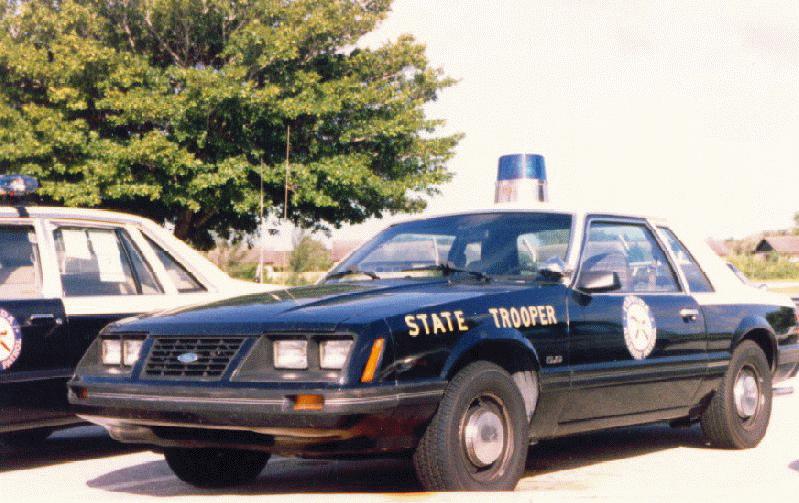 Florida Highway Patrol started using the Special Service Mustang in 1983, when they ordered 40 units for patrol use. That began a run with FHP through the 1993 model year, with FHP buying Mustangs every year. FHP purchased upwards of 1663 of the cars, making them one of the largest users of the SSP Mustang. There are many of these cars left in existence, and many enthusiasts who wish to restore them, as accurately as possible, back to in-service condition. With this in mind, we have compiled the following as a reference to use for restoration, with as much detail and fact-based documentation as possible included. One important note: unlike CHP, where the SSP cars were assembled and made-ready in an assembly-line type environment, FHP allowed individual Troops to outfit the cars. Therefore, many variances in equipment used, as well as the method and location of installment of that equipment, exist.
Florida Highway Patrol started using the Special Service Mustang in 1983, when they ordered 40 units for patrol use. That began a run with FHP through the 1993 model year, with FHP buying Mustangs every year. FHP purchased upwards of 1663 of the cars, making them one of the largest users of the SSP Mustang. There are many of these cars left in existence, and many enthusiasts who wish to restore them, as accurately as possible, back to in-service condition. With this in mind, we have compiled the following as a reference to use for restoration, with as much detail and fact-based documentation as possible included. One important note: unlike CHP, where the SSP cars were assembled and made-ready in an assembly-line type environment, FHP allowed individual Troops to outfit the cars. Therefore, many variances in equipment used, as well as the method and location of installment of that equipment, exist.
Ordering History
1983 was the first year for the Special Service Mustang’s availability to agencies other than CHP. FHP special-ordered their units with the VASCAR speedometer cable option, and little else (non-standard package options). The cars were based on the “L” trim line, with high-back, cloth bucket seats, interior code “D” for Walnut.
1984-1985 saw increased use of the cars, which were still ordered with minimal DSO options. The marked units all were ordered with interior code “H” for Desert Tan for the 1984s (“LX” based coupes, new for 1984) and “Y” for the Sand Beige 1985s (“LX” coupes, FHP ordered Sand Beige interiors until 1989).
In 1986, FHP cars started receiving more in the way of the SSP-specific option content (newly available to all agencies for 1986). FHP started ordering their cars with the new, blue silicon heavy duty hoses (with “aircraft-style clamps”), and Police fan clutch, in addition to the other, standard –production SSP options.
For 1987, FHP ordered cars with the optional oil coolers, and they continued to order the cars with these until 1993 (just like the VASCAR option). For some reason, Florida build-sheets do not list the oil cooler option in the comments section, but all ’87-’93 cars came with them (Other states’ orders do show the cooler on the build.). 1987 was also the first year that Florida cars received the single-key locking system (the option actually became standard, and it was now optional to opt out on the locking system).
In 1988, FHP first ordered the optional LESTEK alternators (with external voltage regulators). FHP continued to order the upgraded alternators through 1993 (’92 and ’93 were the internally-regulated Motorcraft versions).
1990 saw the first year of a new interior color, which was Titanium (code “A”). FHP also ordered all of their ’90 and ‘91s with power locks/windows. They returned back to manual locks/windows for the 1992-1993 model years.
For 1993, Ford discontinued Titanium and offered Opal grey (code “6”).
Paint Information
FHP ordered their marked Mustangs factory painted in the Patrol's "Black and Tan" color scheme. The colors and scheme are defined by
Florida State Statute for the Patrol's use exclusively. Ford painted the entire car in the tan color, which is actually referred to as "cream" by Ford, then masked and painted the black over the cream areas. The trunk was not on the car when it was painted black, which is why the
trunk hinges and inner trunk area (trunk floor and sides) are black, and the underside of the decklid itself is cream. The underside of the hood, inner fenders, engine compartment, and door-jambs are all black. Paint codes changed over the years, with the 1983 code for the cream color listed as WT 1077, and
for 1993 the color listed as WT1677. Ford used tape stripes to mask the car off for the special paint, which are pictured below.
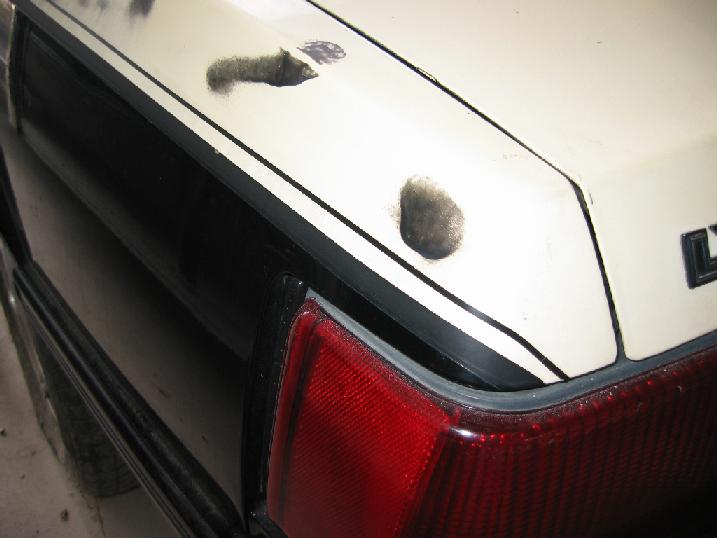
1993 FHP unit #1187 (unrestored, with upper and lower tape stripes).
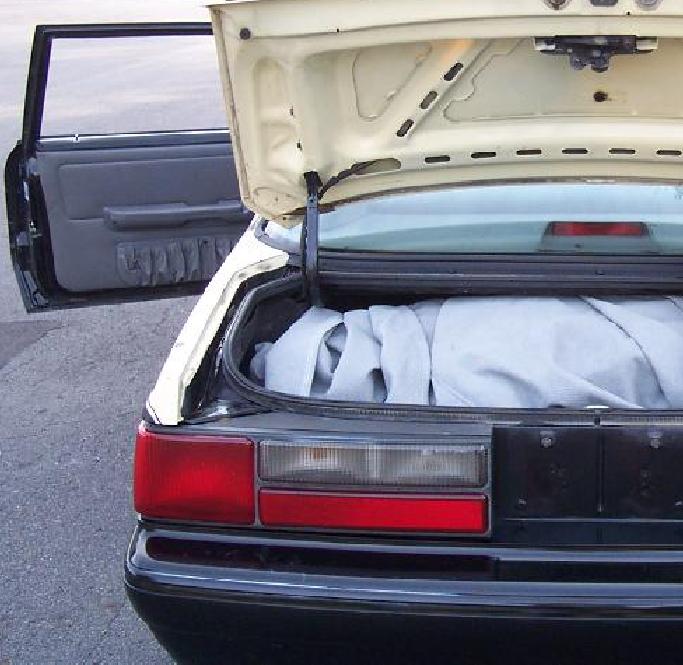
Another shot of FHP 1187, showing the black paint break between the trunk and quarter.
Other unrestored, or actual in-service vehicles, have been seen with cream paint in between the quarter and trunk. This may have been due to differences in how the cars were masked
when they were painted at the factory, repaints while the cars were in-service, or any number of other, unknown reasons.
Emergency Lighting & Equipment
For 1983, FHP ran their full-size Federal CJ184 beacon on top, with no rear decklights. The siren speaker was located inside the beacon’s housing.
For 1984-1993, FHP used 48-inch Jetsonic lightbars (primarily, but there are a few exceptions). The model used is the older, chain-driven bar. The rotators also served double-duty as flashers, and the bars were equipped with a relay control box that allowed the rotators to go to predetermined positions and then stop, changing from rotating lights to flashing lights. The bars had a front-light cutout option, which was necessary for rear flashers, but it also allowed Troopers to display rotating lights to the rear only. Take-down lights were mounted on the outside ends of the bars, facing forward, and alley lights were also mounted on the left and right side. The siren speaker was mounted in the center section of the bar. The Jetsonics were controlled by Federal Signal JSS model switchboxes, which enabled the various functions of the bar.
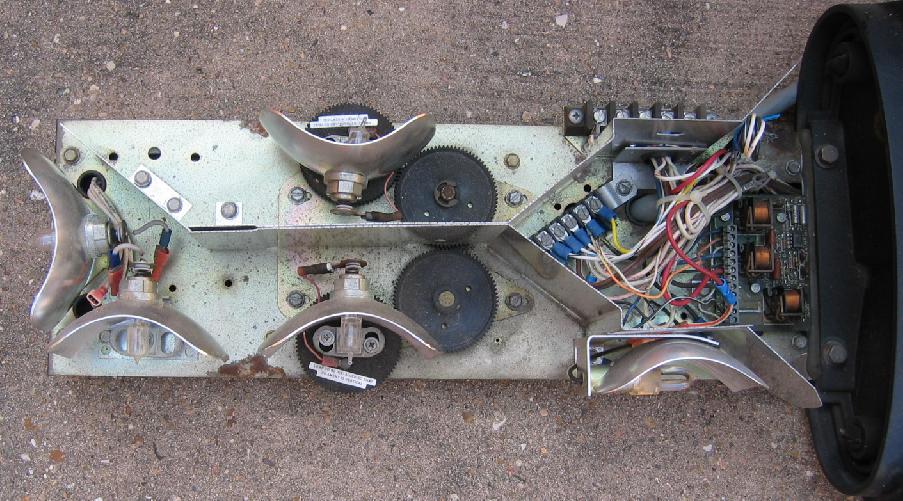 Correct FHP, gear driven bar. Notice the plastic gears that are turned from beneath,
Correct FHP, gear driven bar. Notice the plastic gears that are turned from beneath,
and the full length cascade mirrors. The inboard bayonet strobes were added and are
period-correct, although not something that the bars were originally equipped with.
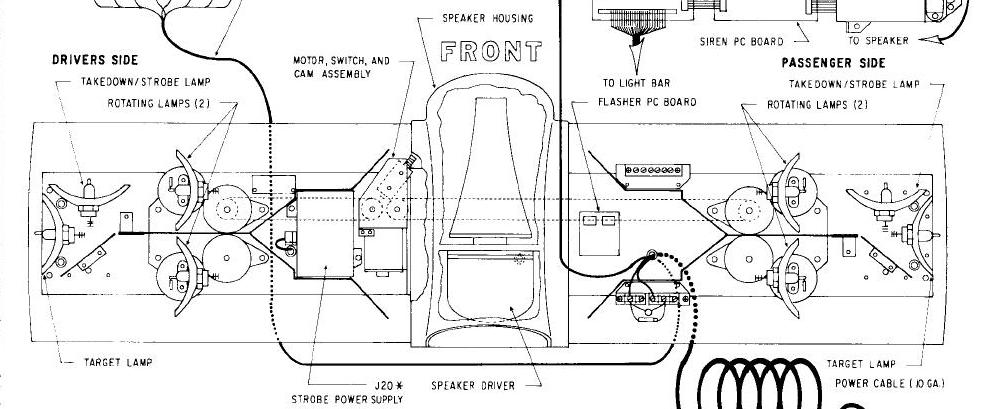 Federal Signal Jetsonic diagram, correct FHP JS2 version.
Federal Signal Jetsonic diagram, correct FHP JS2 version.
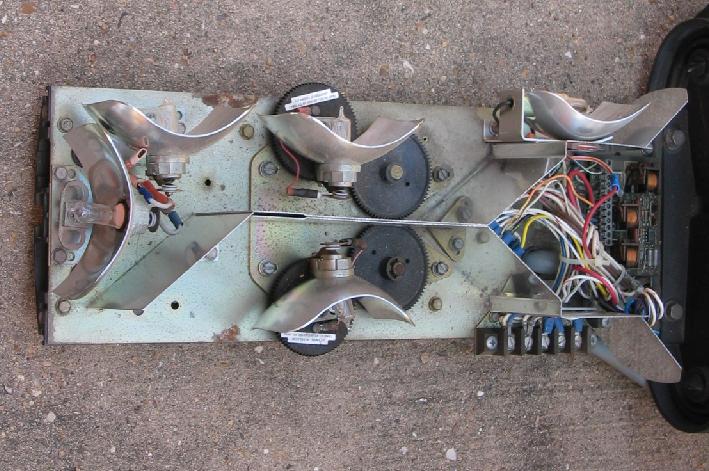
Another shot of the correct bar, with control relay.
|
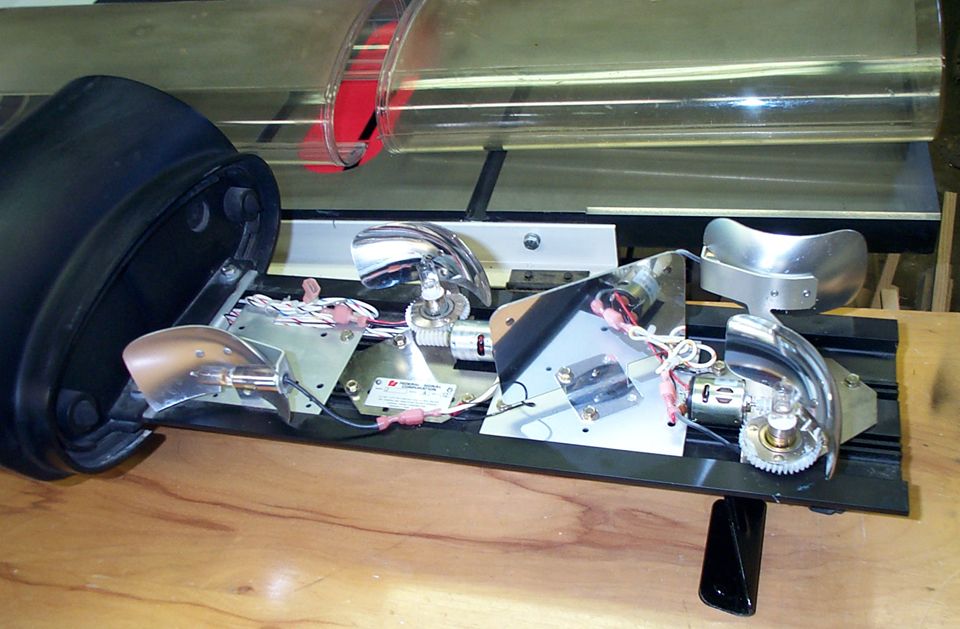
Newer, modular Jet for comparison.
|
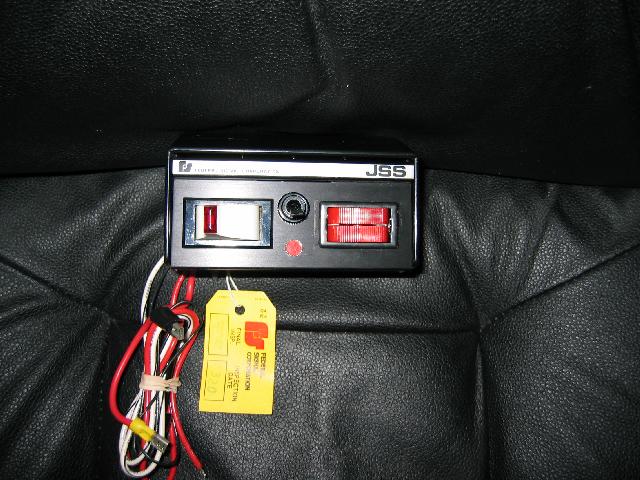
NOS JSS controller, used through the 1993 Mustangs.
|
Rear deck lights started being used around 1989, although there have been several photos of in-service cars without them through 1990. Lights used included the Whelen Dash-Master model and Federal Signal models (two models, the round DST model made by Tomar, and the square Federal Signal). All of these deck lights are self-contained models, and they did not require a separate power supply in order to function. The round Tomars really started appearing in some 1992-1993 cars, and some unmarked cars reportedly received them as well. For the most part, the marked units used the Dash-Master lights.
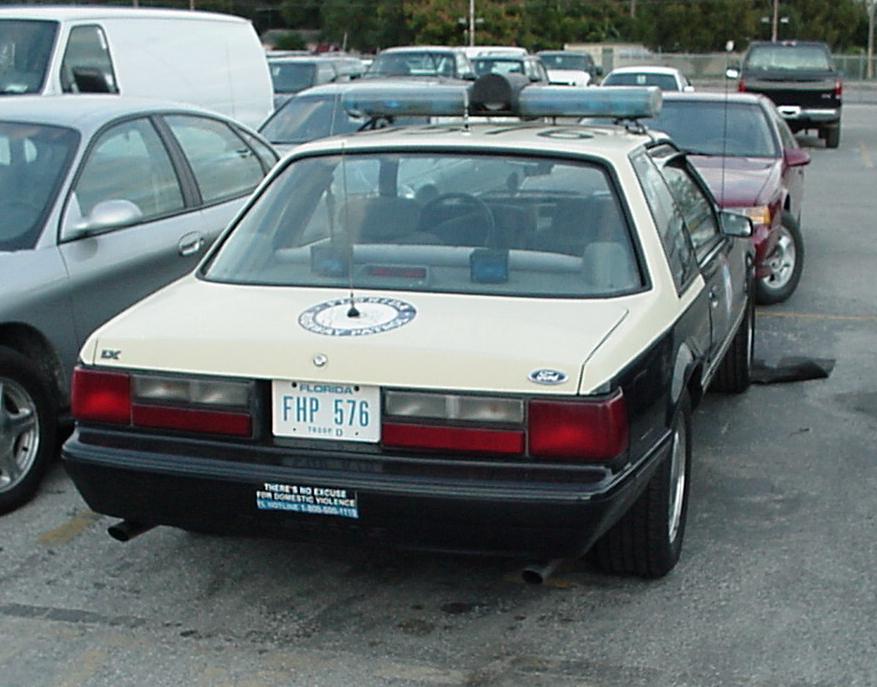
In-Service Dash-Masters, circa 2000, unit #0576. This photo was taken at a Ford dealership in Orlando. |
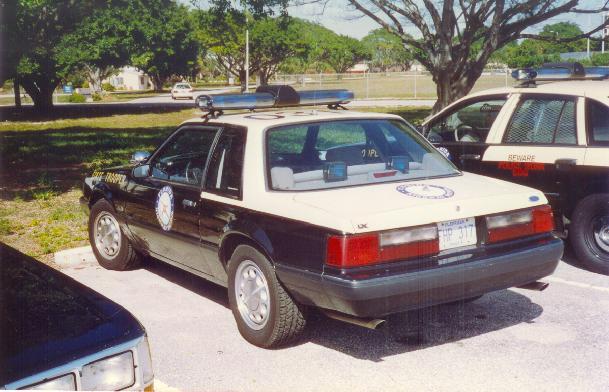
Here are a pair of the Federals in-service, unit #0317. 1992 photo.
|
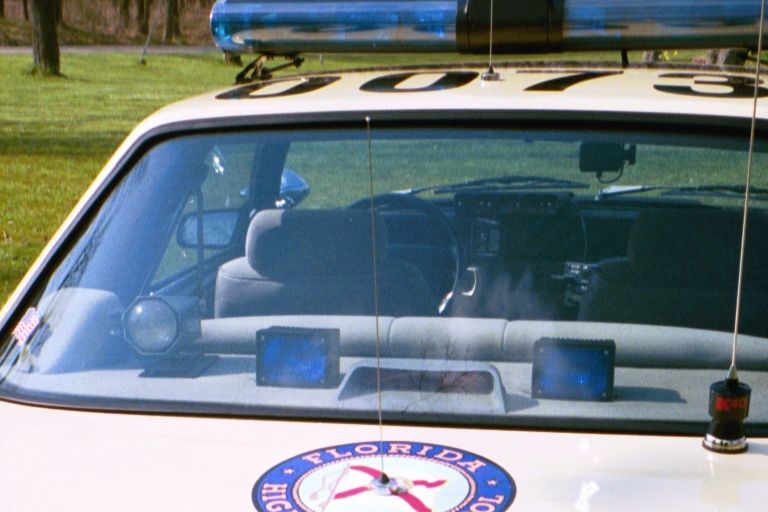
Here is another shot of the Whelen Dashmasters. This '92 was restored by Jim Young, unit #0073.
| 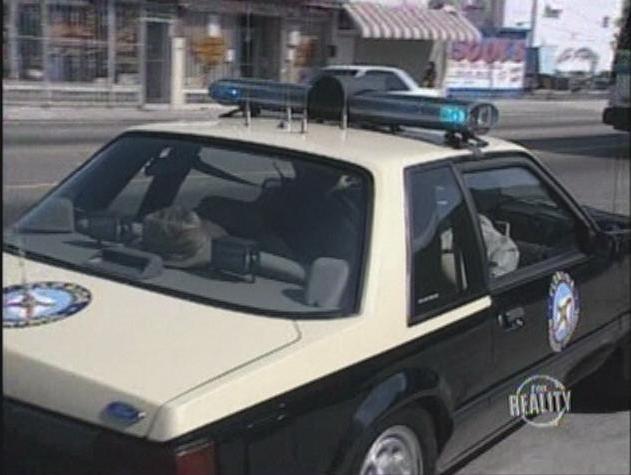
Here is another pair of the Federals, 1994. This car also has the Lo-Jack vehicle recovery system (the four-antenna array on the roof), and no roof numbers.
Image courtesy of Real Stories of the Highway Patrol television series
|
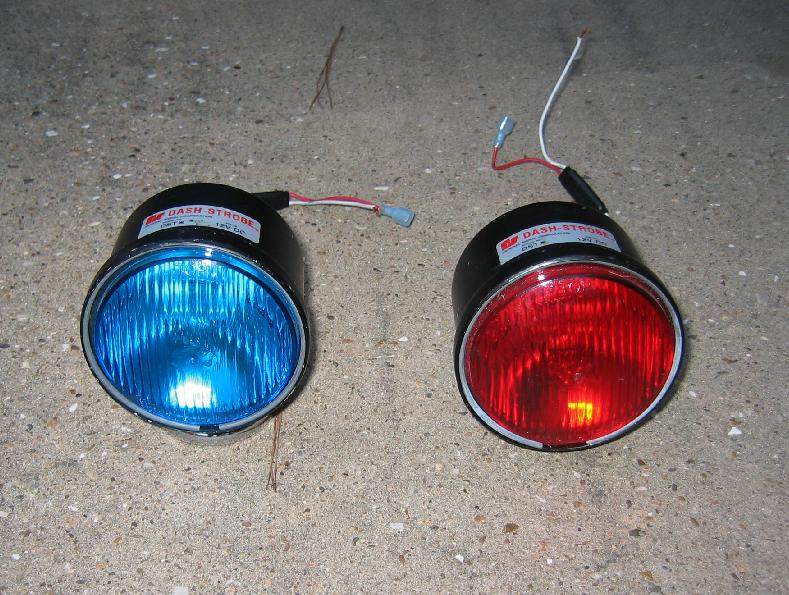
Here is the round, Federal (Tomar) typically blue/blue.
|
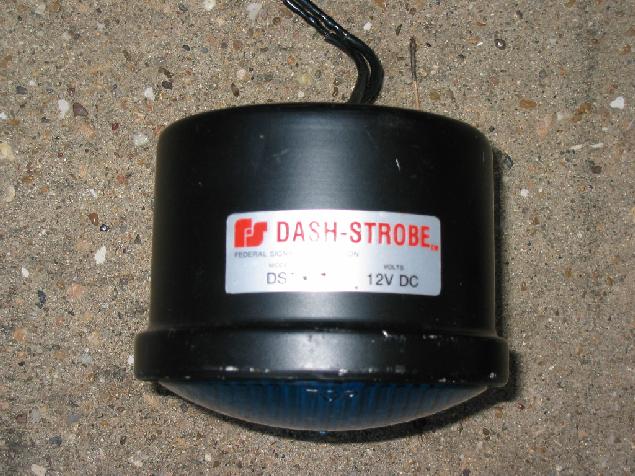
One more of the round, Federal.
|
Dash lights have been seen in various cars, and individual Troopers could add whatever they wanted up front. These cars were take-home units, and Troopers could add equipment such as dash lights without issue. However, FHP policy strictly forbids Troopers from making modifications to their patrol vehicles (meaning any hard-wired install of non-Division issued equipment, without prior approval). Many unmarked cars ran pancake-style lights up front, with deck lights to the rear. Dual Dash-Master strobe units have also been seen up front, both in marked and unmarked cars.
FHP did not typically install headlight or taillight flashers.
FHP did install spotlights on most marked units, and several unmarked cars also received them.
FHP ran several different sirens in the cars, and they reused them from car-to-car (as long as they were still serviceable). Whelen WS-295, Federal Signal PA-200, and Federal PA-300 models were all used throughout the Mustang run. Several different microphone styles for the PA functions have also been seen.
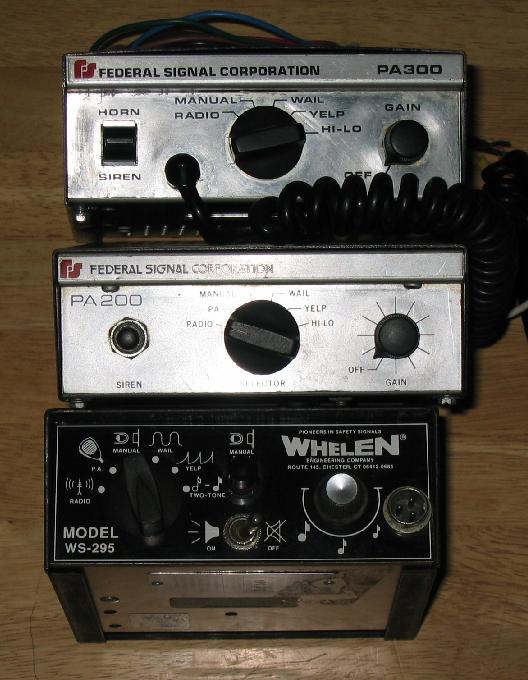
Here are a few of the most commonly used sirens. Federal PA300 top, PA200 below, Whelen WS-295 bottom.
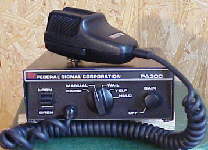
Another version (black face) Federal PA300.
Markings
FHP’s door seals are about 13 inches in diameter, and the correct Mustang seals were screen-printed on non-reflective adhesive. The flag faces rearward on the seals on both doors. The seals went through a very minor revision in the early 80s. This may have been due to the outsourcing of the manufacturing of the seals, which were originally produced in Lakeland, FL. The older seals have a slightly different font (larger, thicker letters). The newer seals are printed on 3M-reflective adhesive, and that change occurred in around 2001. FHP still has a re-marked Special Service Mustang, now unit #1993, with the newer seals and fender lettering.
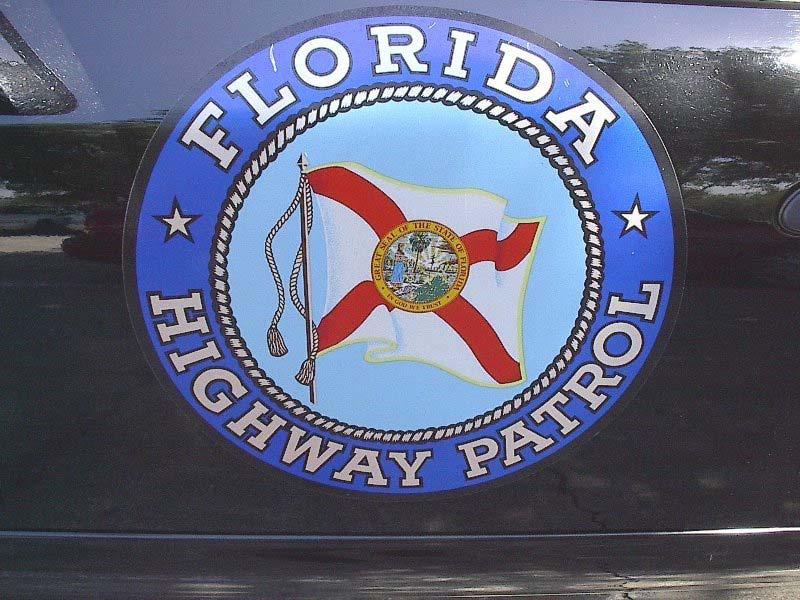
Drivers door seal. Jim Young photo.
Fender lettering for the cars varied slightly, but was usually 3 inches tall and non-reflective on the early cars. Numerous later cars (1988-1993) have been seen with both reflective and non-reflective styles. The differences in the actual fonts used can be easily seen when you compare the newer lettering on unit #1993, with a picture of an older unit (look at the last “R” in Trooper). Other cars have been photographed in-service with the other font (curved “R”), but the majority were the earlier version. Positioning also varied slightly, depending on the installer. Measurements from FHP #1187 (unrestored, with the decal renmants still on the car as pictured below) are as follows: 1/2 thick letters (stroke), 37 1/2 inches wide. "STATE" is 13 inches long, then a 6 inch space, then "TROOPER" which is 18 1/2 inches long.
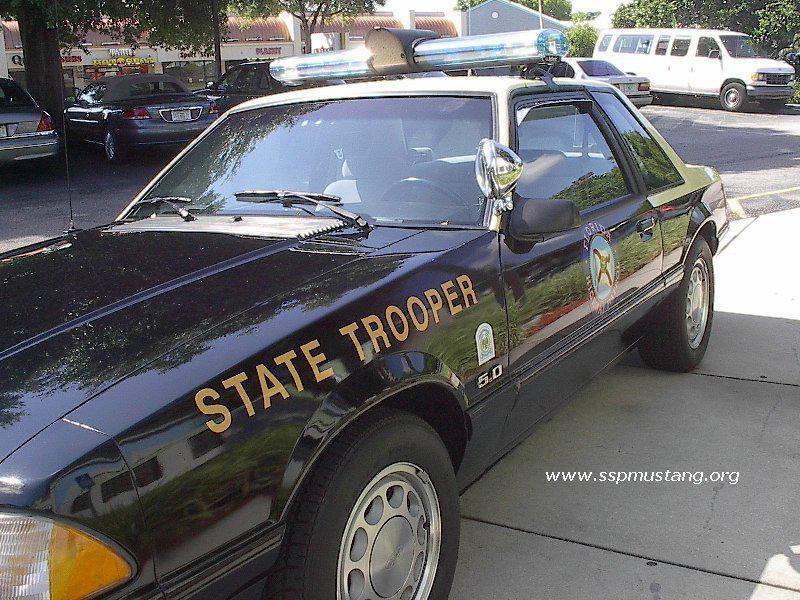
The re-marked, FHP Mustang still "in-service", unit #1993. This car has updated fender lettering and a smaller accreditation decal than what was originally used.
|
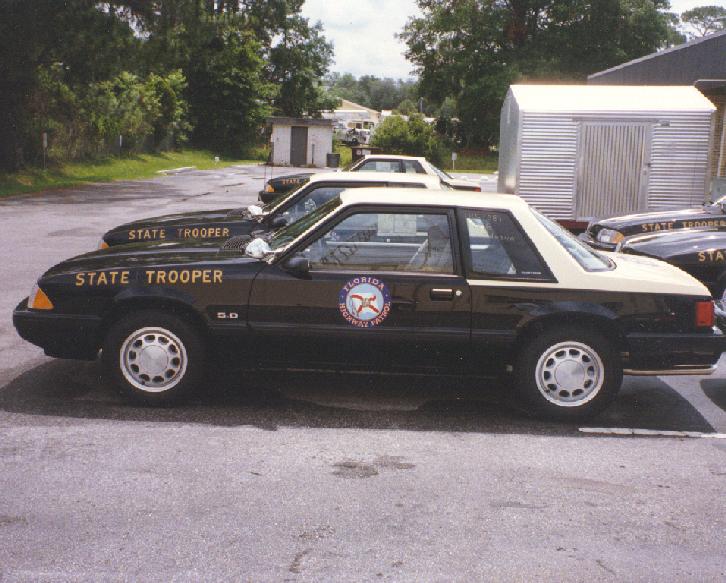
Here are several brand-new 1990's.
|
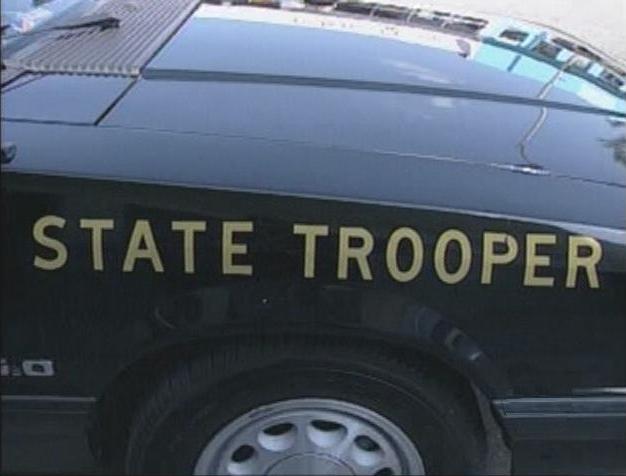
Here is an in-service pic of the lettering, circa 1994. Compare the
color with #1993 (upper left pic), and also the font style. These
appear to be reflective.
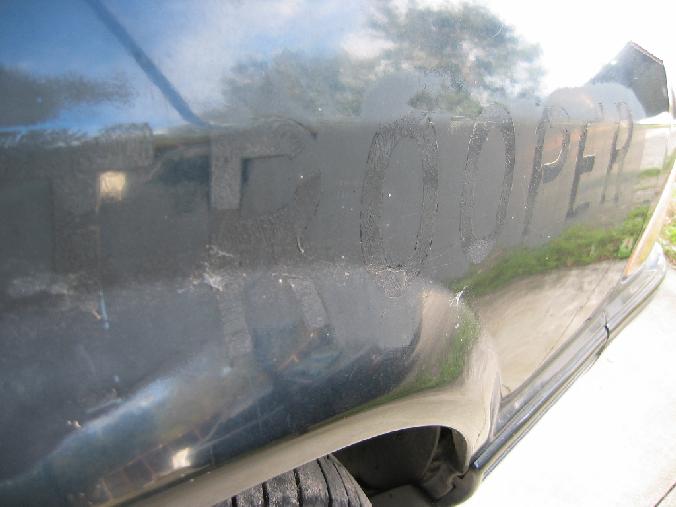
FHP 1187, unrestored, as prepped at the auction.
|
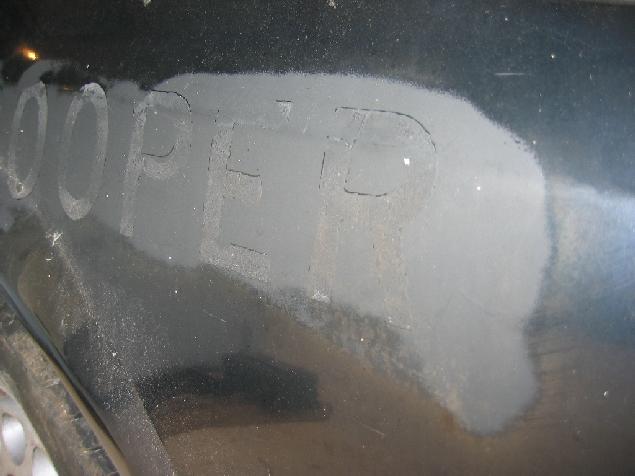
Another shot of the lettering and font.
|
Most marked cars received roof numbers, after 1986 (they started sometime between 1986 and 1987) and the font and size also varied accordingly (various sizes and fonts were used). The FHP used VASCAR to work traffic, and a large part of the program involved the use of aircraft (hence the roof numbers). The unit number, which was also the license tag number, was the number placed on the roof. Roof number measurements for FHP #1187, which are pictured below and are still on the car, are as follows: 2 inches wide (stroke), 15 inches high, 5 inches between the numbers.
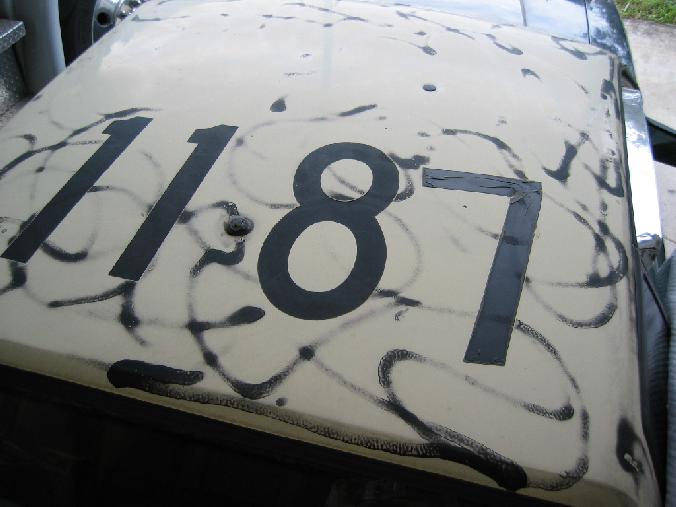
Roof numbers on FHP 1187, unrestored and as purchased from FHP surplus auction in 1997.
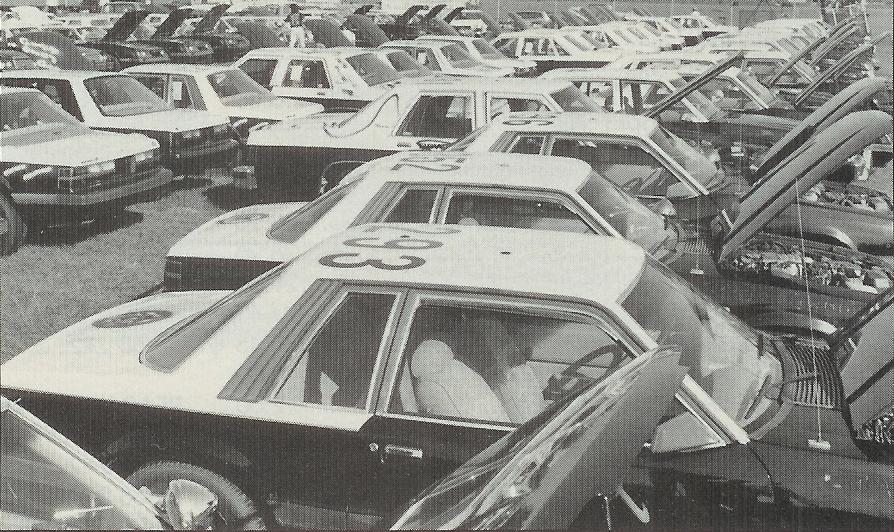
Here are a few 1986 cars at the auction. Image courtesy of Mustang Monthly.
As far as rear lettering on the trunk goes, only the very late service cars from Troop E (Miami) were seen with the lettering (several came through the Orlando auction in 2001). The re-marked Orlando car also has the lettering.
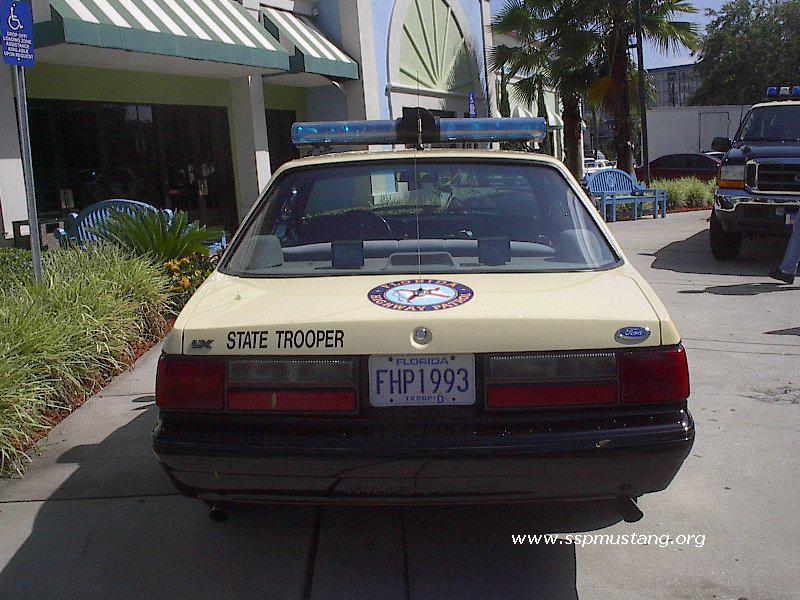
Here is the rear of #1993. Mike Riley photo.
FHP was nationally accredited by CALEA in September 1996, so any cars in-service at that time or after could have had accreditation decals added above the 5.0 emblems.
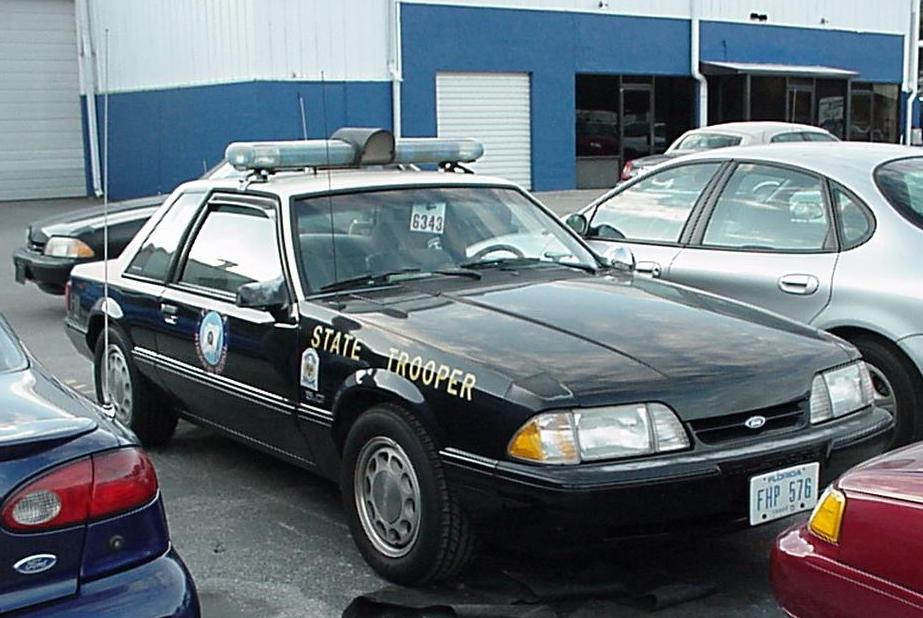
Here is the front of #576, taken in 2000. The black car parked behind it was an FHP unmarked car, purchased earlier in the day at the FHP surplus auction. It was a 5-speed, with a spotlight, and had 78K on it when it sold.
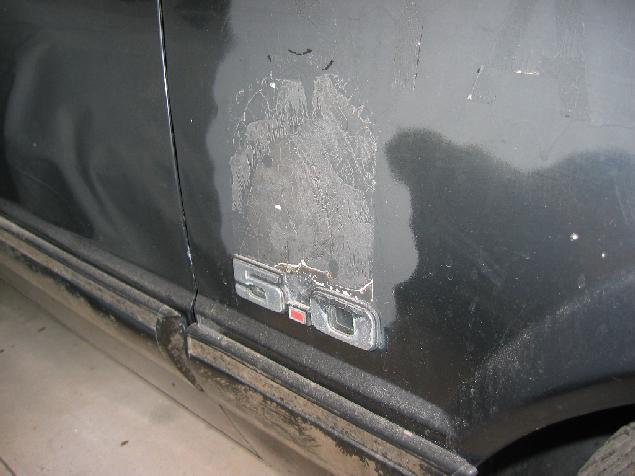
FHP 1187, shot of the accreditation decal above the 5.0 emblem. Auction workers prepped the car for the DOT auction by removing decals and applying black spray-paint.
Florida Highway Patrol Restoration Page 2
Home
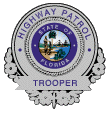

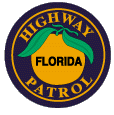



 Florida Highway Patrol started using the Special Service Mustang in 1983, when they ordered 40 units for patrol use. That began a run with FHP through the 1993 model year, with FHP buying Mustangs every year. FHP purchased upwards of 1663 of the cars, making them one of the largest users of the SSP Mustang. There are many of these cars left in existence, and many enthusiasts who wish to restore them, as accurately as possible, back to in-service condition. With this in mind, we have compiled the following as a reference to use for restoration, with as much detail and fact-based documentation as possible included. One important note: unlike CHP, where the SSP cars were assembled and made-ready in an assembly-line type environment, FHP allowed individual Troops to outfit the cars. Therefore, many variances in equipment used, as well as the method and location of installment of that equipment, exist.
Florida Highway Patrol started using the Special Service Mustang in 1983, when they ordered 40 units for patrol use. That began a run with FHP through the 1993 model year, with FHP buying Mustangs every year. FHP purchased upwards of 1663 of the cars, making them one of the largest users of the SSP Mustang. There are many of these cars left in existence, and many enthusiasts who wish to restore them, as accurately as possible, back to in-service condition. With this in mind, we have compiled the following as a reference to use for restoration, with as much detail and fact-based documentation as possible included. One important note: unlike CHP, where the SSP cars were assembled and made-ready in an assembly-line type environment, FHP allowed individual Troops to outfit the cars. Therefore, many variances in equipment used, as well as the method and location of installment of that equipment, exist.





















